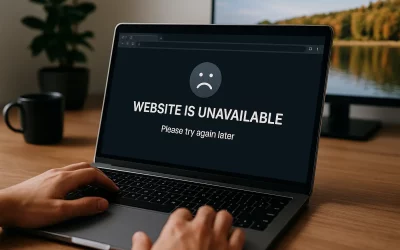The WordPress Plugin Graveyard: What to Ditch in 2025
WordPress is a powerhouse, but it can quickly become a bloated, slow-moving mess if you’re not careful with your plugins. For small businesses running on WordPress web hosting Australia wide, performance, security and SEO matter more than ever. And outdated, unused, or unnecessary plugins could be quietly costing you leads and rankings.
So, let’s take a guided walk through the “WordPress Plugin Graveyard” – a rundown of the plugins you should delete, replace, or avoid entirely in 2025.
Why Cleaning Up Plugins Matters
If you’ve been using WordPress for more than a year, chances are your site has collected some plugin clutter. Here’s why that’s a problem:
- Speed Impact: Each active plugin loads code and scripts that can slow your site.
- Security Risk: Abandoned or poorly maintained plugins are prime targets for hackers.
- Compatibility Headaches: Old plugins often don’t play nice with the latest WordPress updates.
- SEO Damage: A slow or buggy site can directly hurt your rankings.
In short, your plugin list might be the reason your site isn’t loading fast, ranking well, or staying secure. Time for a plugin audit.
RIP: Plugins You Should Retire in 2025
Below are plugins that are no longer maintained, have better alternatives, or are causing more problems than they solve.
1. Jetpack (Bloat Central)
Once a go-to for beginners, Jetpack has become a bloated mess trying to do too many things. It loads excessive scripts, slows down pages, and duplicates functionality you can get elsewhere with better performance. Unless you’re using a single specific module (like downtime monitoring), it’s better to remove it.
2. WPBakery Page Builder
Still hanging on from the early page builder wars, WPBakery is now outdated and often conflicts with modern themes or block-based editors. With Gutenberg and builders like Divi or Oxygen, WPBakery belongs in the past.
3. Revolution Slider
Big, flashy, and heavy on load time. Sliders in general are falling out of favour due to UX and performance issues. Plus, this plugin has had multiple security flaws in past years. Ditch it for lightweight image blocks or modern galleries.
4. Contact Form 7 (with no recaptcha or spam protection)
Yes, it’s popular. But if you’re still using CF7 without recaptcha or spam filters, you’re inviting bots and bad UX. Alternatives like WPForms Lite or Fluent Forms are faster, more secure, and mobile-friendly.
5. Broken Link Checker (Live Scanning = Server Drag)
This plugin checks every internal and external link… constantly. On shared WordPress hosting setups, it can drag performance into the ground. Instead, use a free online tool periodically or install and run it temporarily, then deactivate.
6. EWWW Image Optimizer
This plugin works, but it uses your server resources to compress images. In contrast, plugins like ShortPixel or TinyPNG process images offsite, keeping your load light and fast.
7. Google Analytics by MonsterInsights (free version)
The free version adds bulky scripts without giving you access to proper GA4 insights. Use Site Kit by Google for tighter integration or switch to server-side tracking setups.
Plugins That Might Be Quietly Harming Your Site
Some plugins aren’t broken – they’re just not necessary anymore. If your site has grown up, these may now be liabilities:
- XML Sitemaps plugin: WordPress has sitemap functionality built-in since version 5.5.
- Classic Editor: If you’re still relying on this, it’s time to embrace the block editor and move forward.
- Multiple caching plugins: One is enough. Using multiple can cause conflicts and strange bugs.
Signs a Plugin Needs to Go
Even if a plugin isn’t on our graveyard list, it might still need the axe. Ask yourself:
- Has it been updated in the last 6–12 months?
- Is it compatible with the current WordPress version?
- Is the plugin author responsive to support requests?
- Are there recent negative reviews about speed or bugs?
If the answer to any of the above is “no” – it’s time to replace it or remove it.
Smart Replacements for Retired Plugins
Here are some lighter, modern alternatives to commonly overused or outdated tools:
| Old Plugin | Modern Alternative |
|---|---|
| Contact Form 7 | Fluent Forms, WPForms Lite |
| Slider Revolution | Smart Slider 3 (only if needed), Block-based images |
| Jetpack | Separate tools: ShortPixel, UpdraftPlus, etc. |
| Broken Link Checker | Ahrefs or Screaming Frog (manual scans) |
How Hosting Impacts Plugin Performance
Even the best plugins will struggle on poor hosting. If you’re running bloated plugins on overseas servers or shared environments with no optimisation, you’re stacking the odds against yourself. Choose WordPress web hosting Australia plans that offer LiteSpeed caching, image compression, and database optimisation tools built-in.
Better hosting can eliminate the need for certain plugins altogether. For example, many VPS hosting environments come with built-in server-side firewalls, backups, and performance tuning that reduce your plugin dependence significantly.
Pro Tip: Regular Plugin Audits
Set a quarterly reminder to run a plugin audit. Use this checklist:
- Check plugin update history
- Review active plugin list for duplicates or overlap
- Use Query Monitor to spot performance hogs
- Deactivate and test – some plugins may not even be doing anything anymore
If you’re managing multiple client sites, consider a staging server to safely test plugin changes before pushing live.
Final Word: Keep It Lean, Fast, and Secure
Plugins are powerful – but too many, or the wrong ones, are a liability. Clean up your plugin list, keep only what’s essential, and rely on quality hosting to carry the rest. Your site will load faster, stay safer, and convert better – all without the drag of digital dead weight.
Need help moving to Australian WordPress Hosting that’s built for performance? Contact us here and we’ll assess your setup – plugin bloat and all.







